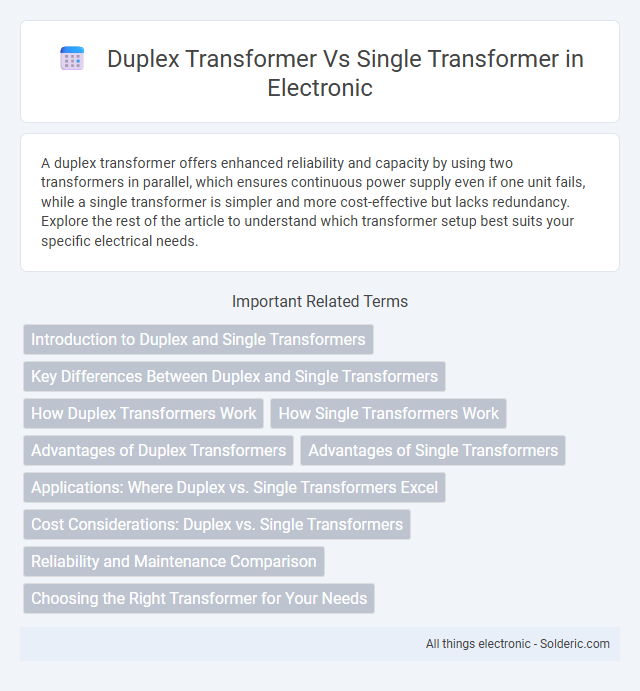A duplex transformer offers enhanced reliability and capacity by using two transformers in parallel, which ensures continuous power supply even if one unit fails, while a single transformer is simpler and more cost-effective but lacks redundancy. Explore the rest of the article to understand which transformer setup best suits your specific electrical needs.
Comparison Table
| Feature | Duplex Transformer | Single Transformer |
|---|---|---|
| Definition | Two transformers working simultaneously for redundancy or increased capacity | Single transformer used alone for power delivery |
| Reliability | High, due to redundancy | Lower, single point of failure |
| Capacity | Higher combined capacity | Limited to one unit's rating |
| Cost | Higher initial and maintenance costs | Lower initial costs |
| Maintenance | Easier with one transformer operational during servicing | Requires shutdown for maintenance |
| Application | Critical systems requiring continuous power | Non-critical or cost-sensitive applications |
Introduction to Duplex and Single Transformers
Duplex transformers consist of two separate transformer units within a single enclosure, allowing for redundancy and increased reliability in power distribution systems. Single transformers contain only one transformer unit, providing a straightforward and cost-effective solution for simpler electrical setups. Your choice between duplex and single transformers depends on system redundancy requirements and budget constraints.
Key Differences Between Duplex and Single Transformers
Duplex transformers consist of two windings with separate magnetic cores offering redundancy and improved reliability, whereas single transformers have only one winding and core, making them simpler but less fault-tolerant. Duplex transformers are ideal for critical applications requiring continuous operation, while single transformers are commonly used in less demanding environments due to their cost-effectiveness and straightforward design. The efficiency, maintenance, and operational flexibility of duplex transformers generally surpass those of single transformers, especially in industrial and power distribution systems.
How Duplex Transformers Work
Duplex transformers operate by using two independent transformer units within a single enclosure, each capable of handling separate loads to enhance reliability and flexibility. These transformers share a common secondary winding connection, allowing automatic load transfer between them during maintenance or failure, ensuring continuous power supply. Your system benefits from reduced downtime and increased operational efficiency when using a duplex transformer compared to a single transformer setup.
How Single Transformers Work
Single transformers operate by transferring electrical energy between two or more coils through electromagnetic induction, typically featuring a primary and a secondary winding. The primary winding receives the input voltage, which creates a magnetic field that induces a voltage in the secondary winding, allowing for voltage step-up or step-down applications. Understanding how single transformers work can help you choose the right device for efficient power distribution and voltage regulation in your electrical systems.
Advantages of Duplex Transformers
Duplex transformers provide enhanced reliability by allowing continuous power supply through automatic switching if one transformer fails, reducing downtime and maintenance costs. They improve load management by sharing the electrical load, which minimizes overheating and extends the lifespan of each transformer. Your electrical system benefits from increased efficiency and safety, making duplex transformers ideal for critical applications requiring uninterrupted power.
Advantages of Single Transformers
Single transformers offer advantages such as simpler design and lower initial cost compared to duplex transformers, making them ideal for applications with limited space or budget constraints. They typically require less maintenance due to having fewer components, increasing reliability and reducing downtime. Your system benefits from straightforward installation and easier troubleshooting, enhancing overall operational efficiency.
Applications: Where Duplex vs. Single Transformers Excel
Duplex transformers excel in applications requiring enhanced reliability and load sharing, such as in data centers and industrial automation where continuous power supply is critical. Single transformers are ideal for simpler, cost-effective setups like residential or small commercial electrical distribution where load demands are moderate. Your choice depends on whether system redundancy and higher capacity management or straightforward power delivery is the priority.
Cost Considerations: Duplex vs. Single Transformers
Duplex transformers typically incur higher initial costs compared to single transformers due to the duplication of components and increased complexity in design and installation. However, duplex transformers offer enhanced reliability and operational flexibility, potentially reducing long-term maintenance expenses and downtime. Single transformers provide a cost-efficient solution for applications with lower power demands or simpler load profiles, balancing upfront savings with potential risks of service interruptions.
Reliability and Maintenance Comparison
Duplex transformers offer higher reliability than single transformers by providing redundancy; if one unit fails, the other continues to operate, minimizing downtime. Maintenance is more manageable with duplex systems, as you can service one transformer without interrupting power supply, enhancing operational continuity. Your choice between duplex and single transformers should consider the criticality of uninterrupted service and maintenance flexibility.
Choosing the Right Transformer for Your Needs
Selecting between a duplex transformer and a single transformer depends on your load requirements and reliability needs. Duplex transformers offer redundancy and improved system reliability by allowing one transformer to serve as a backup, ideal for critical applications where uptime is essential. Single transformers are more cost-effective and simpler for steady, lower-demand loads where backup power is less critical for your operations.
duplex transformer vs single transformer Infographic

 solderic.com
solderic.com